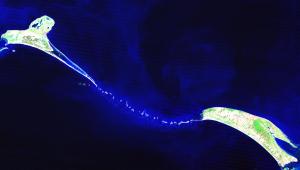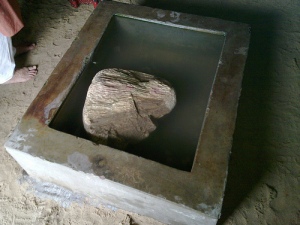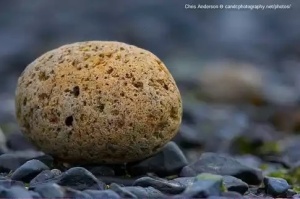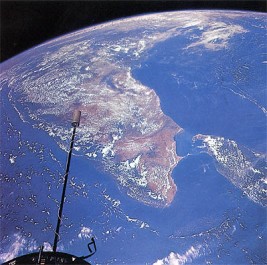Around thousands of years ago, a bridge was made to cross over Indian Ocean, whose distance is estimated to be around 30 kms now and that too in just 5 days. Some statistics may be indigestible as even now it is impossible to make a bridge that long in just 5 days even with the latest technologies we have. We are talking about the Ram Setu or the Adam’s Bridge (Sri Lankans version because they think this bridge was there since the starting of mankind).
Ram Setu has been nothing but a masterpiece of engineering and work of art, if we believe that it was made during Ramayana i.e 1.7 million years before, where there was not even a hint of advanced machineries and technology that we possess today.
Why and how Ram Setu was built?
In the epic poetry of Ramayana, the construction of Rama Setu is decribed in the chapter ‘Yuddha Kanda‘ , but the description is rather obscure. Rama wanted to cross the ocean to bring back his wife Sita from the clutches of Ravana and so he requested God Varuna, the Ocean God to make a way for him or help him and his sena (army) to cross the ocean. When the Ocean God didn’t pay any heed to Rama’s request, Rama took out an arrow out of his bow to dry up the ocean which would have made a path for him to reach Lanka. The God of Ocean was so terrified listening to this and appeared and suggested that Nala, who happened to be a son of Vishvakarma; was given a boon that any stone he will put into the sea will float.
The above incident of Nala is given in Ramayana written by Valmiki, whereas Ramcharitmanas written by Tulsidas credits both Nala and Neela ( son of Lord Agni ) as the masterminds behind the building of Ram Setu. It is believed that both were so notorious in their childhood that they used to throw the sculptures made by Sages into the river and hence, were given a curse that whatever they will throw in water will flow and this turned out to be a boon for Rama when they had to cross the ocean. Another tale narrates as assured by Varuna, the stones dropped by Nala and Nila would forever float, but with the condition that they would drift in the sea without forming a contiguous structure. The version also has Hanuman suggesting the name of Rama be written across the stones so that they stick together, and describes the strategy as overcoming the proviso. It took around 5 days to build the Rama Setu with the help of 10 million Vanaras (monkeys).
Conflict between science and mythology.
There have been speculations arising on the bridge stating it occurred due to the natural causes. Even NASA claims that Ram Setu is due to the natural process that occurred long back but can’t back their statements with appropriate evidence.
Stone found in Rameshwaram
Pumice Stone
The floating stones described in Ramayana, referred as Pumice Stones by modern science, occur due to the Volcanic eruptions and have a tendency to float on water. But when we look at geographical location of the place, one finds out that there has been no volcanic eruptions occurred in and around that place which could have resulted into occurrence of Pumice Stones in the making of Ram Setu. The Pumice Stones are white or cream in colour whereas the floating stones found in Rameshwaram are black in colour.
Many scientists also described Ram Setu as nothing but the coral formation, but there is nothing like floating corals because coral is calcium carbonate, and its chemical composition is too dense to float on water. Moreover, the coral stone doesn’t occur in sea and occurs only on hard surfaces. The floating stones that were found in Rameshwaram even doesn’t seem to be made up of calcium carbonate.
The reason why we believe Ram Setu to be a man-made masterpiece
The route depicted in Valmiki Ramayana where, Lord Rama leaves Rameshwaram after worshiping Lord Shiva’s Shivling and when he reaches Lanka (present Sri Lanka), he goes and worships again at a Shivling in Ketheeswaram temple presently at Mannar, Sri Lanka. If we look at the images produced by satellites and compare it with the incidents depicted in Ramayana, we can come to a conclusion that Ram Setu was definitely made by humans.
Temple records say that Rama Setu Bridge was completely above sea level until it broke in a cyclone in AD 1480. Ram Setu was walkable till 1480 AD.
The clear manifestation stated above proves that the Ram Setu is an engineering masterpiece until Scientists comes out with strong theory to prove us wrong.
Admirable India
Post by: Arjun Rathod








Truly a masterpiece….
LikeLike
Should be declared as a National Heritage.
LikeLike
I have always been intrigued when it came to the Ram Setu. Lovely information! 🙂 But if there haven’t been any volcanic eruptions nearby, how did they procure so many pumice stones? 🙂
LikeLike
The scientists say thats it was pumice stones but their assumptions went wrong when the stones found in Rameshwaram which were of different origin.
LikeLike